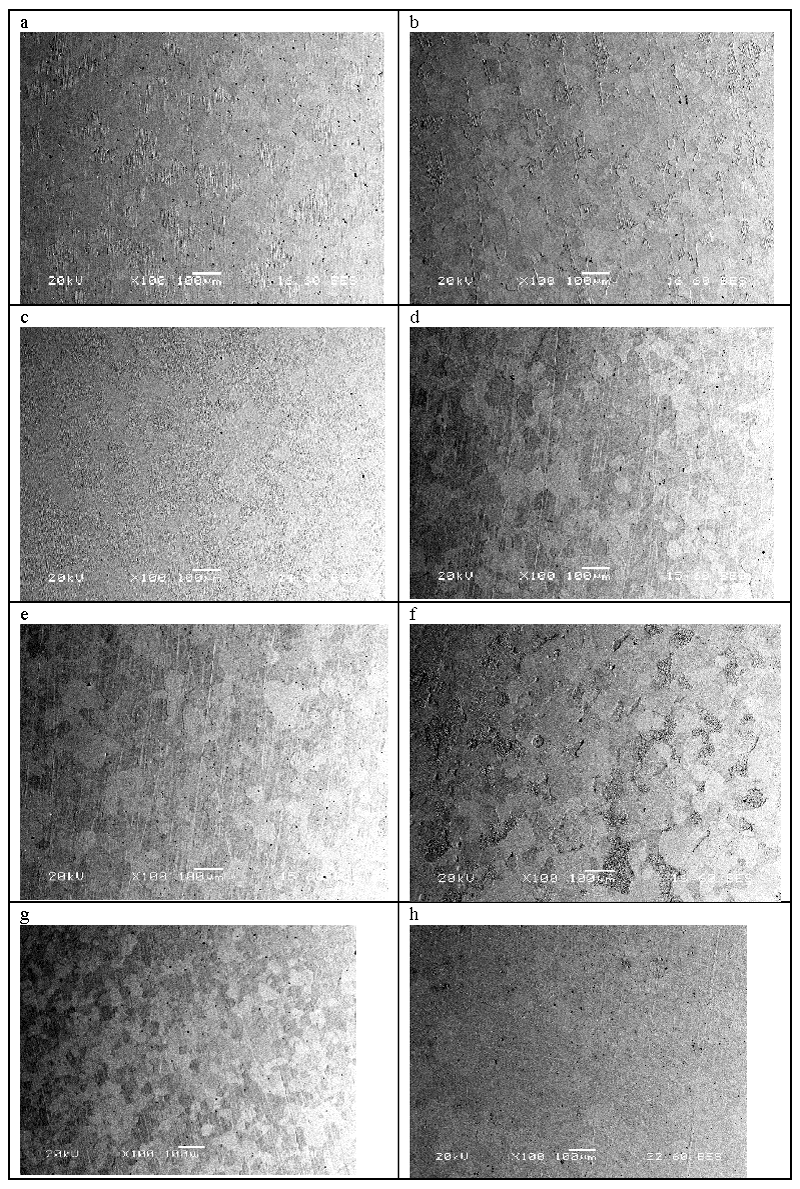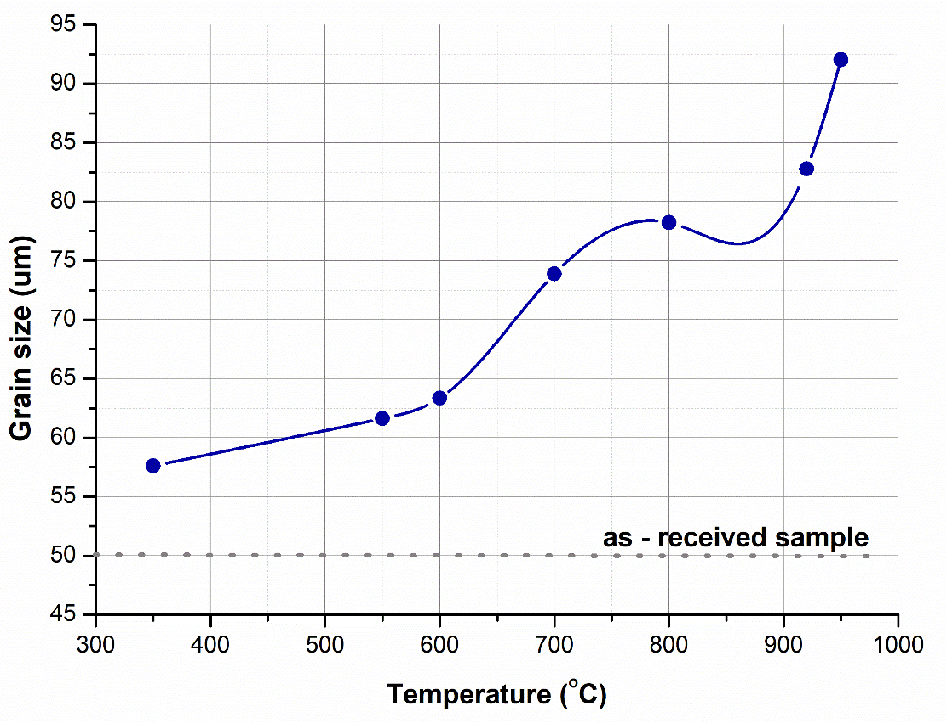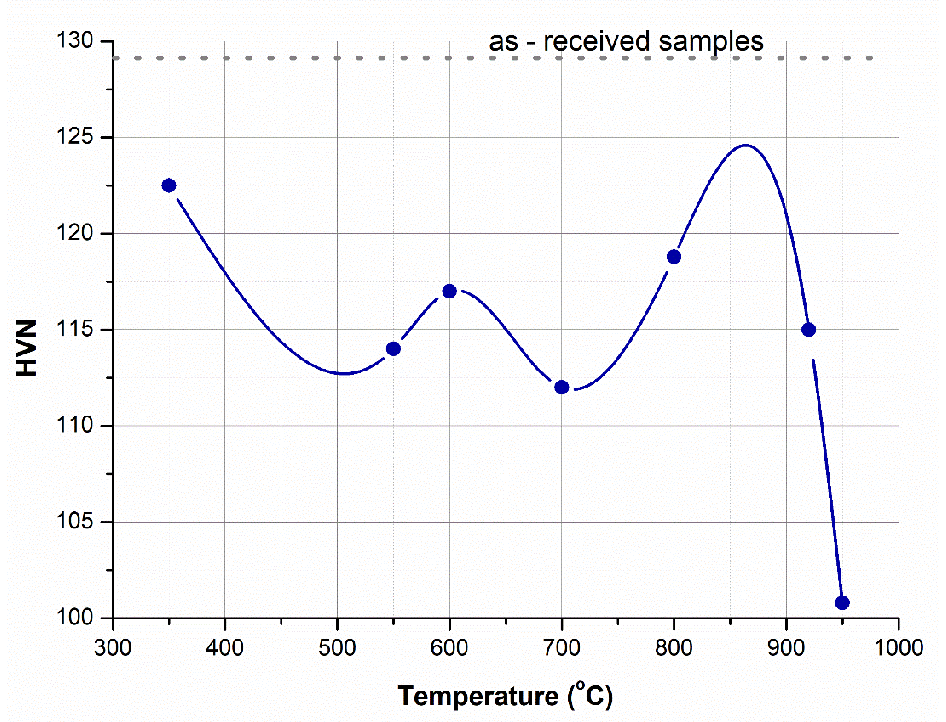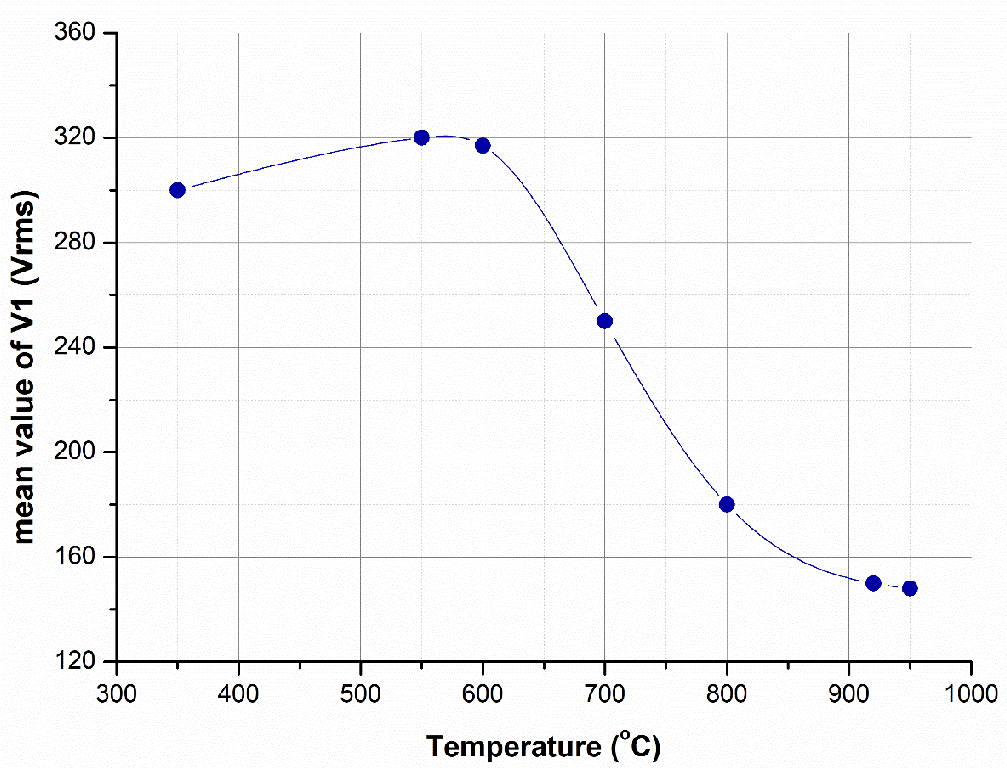Annals of Marine Science
Temperature effects on grain growth phenomena and magnetic properties of silicon steels used in marine applications
Nikolaos D Papadopoulos1*, Polyxeni Vourna2, Nikos Stefanakis2, Sotirios Xafakis1 and Evangelos Hristoforou2
2Laboratory of Electronic Sensors, Institute of Communication and Computer Systems, School of Electrical and Computer Engineering, National Technical University of Athens, 9 Ir. Polytech. St., Zografou, 15780, Greece.
Cite this as
Papadopoulos ND, Vourna P, Stefanakis N, Xafakis S, Hristoforou E (2023) Temperature effects on grain growth phenomena and magnetic properties of silicon steels used in marine applications. Ann Mar Sci 7(1): 040-044. DOI: 10.17352/ams.000037Copyright License
© 2023 Papadopoulos ND, et al. This is an open-access article distributed under the terms of the Creative Commons Attribution License, which permits unrestricted use, distribution, and reproduction in any medium, provided the original author and source are credited.The present paper investigates the stages of the microstructure and texture evolution in non-oriented electrical silicon steels by means of magnetic measurements and metallographic analysis. The goal of this work was to study temperature effects and their influence on grain growth processes in non-oriented electrical steels while being subjected to different annealing conditions and to clarify the mechanism of grain boundary motion during annealing. It is important to study the development of texture and grain size in electrical steel samples along the entire production line chain (hot rolling, cold rolling, and final annealing), as both are affected by each processing stage. The lack of magnetic data dependent on the operating temperature of non-oriented electrical steels makes it impossible to accurately design high-power motors (e.g., propulsion systems in ships) or generators that are to operate at high temperatures. The correlation of magnetic properties with the microstructure of electrical steels can yield important information about their suitability for various substrates and marine applications. In addition, it can potentially non-destructively define both the annealing stage and the preferred crystallographic growth pattern in single-phase ferritic steels, which affect the performance and longevity of the electromagnetic devices in which these are used.
Introduction
A wide range of technologically important properties in polycrystalline materials are controlled by their microstructure [1]. Undoubtedly, improvements in the performance of electrical devices have led to the optimization of existing magnetic materials [2].
In the case of soft magnetic materials especially, such as iron and low carbon steels, the microstructure is a critical feature. High permeability and low iron loss are sought, in order to achieve higher efficiencies and energy savings. Therefore, it is important to control the microstructure of steel in terms of grain size, texture, and microstructural homogeneity. During magnetization, these parameters may affect domain size and thus the material’s core loss [3,4].
Silicon steels are alloys of iron and silicon that have found extensive applications in transformers and electrical machines of all sorts and sizes. They are largely divided into oriented and Non-Oriented (NO) steel sheets. The variety of NO electrical sheets in general depends on the content of Si, which is a ferrite stabilizer. It is known that resistivity rises as the Si content increases. Thus, power loss (particularly eddy current loss) is reduced. In addition, the phase transformation temperature rises and the anisotropy constant is reduced thus promoting magnetic softness and restricting hysteresis loss [5-8]. It is also known, that in order to promote texture development across the magnetically favorable (100) plane, rolling within the ferrite region and below the austenitization temperature is necessary [9].
Because of its unique properties, silicon steels are widely used as the main core material in motors and generators and over-frequency and high-frequency converters [10,11], especially in the maritime industry. However, in cases where the weight and volume of equipment are limited by strict requirements, such as in naval electromechanical devices, the magnetic behavior of steel should not be compromised by the high temperatures, at which this operates [12]. However, silicon steel manufacturers do not always provide information on its magnetic properties at temperatures other than room temperature. The lack of magnetic data dependent on the operating temperature of non-oriented electrical steels makes it impossible to accurately design high-power motors (e.g., electric propulsion motors in ships) or generators that are to operate at high temperatures. It should be noted that the temperature of non-oriented electrical steels in marine applications may exceed 500 °C.
Grain growth kinetics significantly affects the evolution of the texture and, consequently, the resulting magnetic properties [13,14]. To obtain the appropriate magnetic properties, NO electrical steels are subjected to various anneals in gas mixtures. The reasoning behind this practice is to reduce the carbon content and develop a microstructure with a favorable texture. This thermally activated process initiates both recrystallization and grain growth phenomena. The grain size increases rapidly since the large amount of stored energy in the grains is abruptly released at elevated temperatures. However, the production process induces microstructure inhomogeneity, which is particularly important in NO electrical steels.
Grain boundary migration is an anisotropic process where non-linearity depends on the physical properties of the neighboring grains. The behavior of the grain boundaries under non-equilibrium conditions has been a significant subject of study in recent years [15-17]. Still, there are many unresolved issues in the modeling of microstructural evolution, especially with regard to quantitative predictions during annealing. The abnormal growth of certain types of grains at the expense of others is dependent on the properties of the grain boundaries and on the growth driving force. Investigation of thermal transport phenomena is critical in order to comprehend the mechanism of grain boundary motion [18].
Hence, the present paper investigates the stages of the microstructure and texture evolution in NO electrical steels by means of magnetic measurements and metallographic analysis.
It is important to study the development of texture and grain size in electrical steel samples along the entire production line chain (hot rolling, cold rolling, and final annealing), as both are affected by each processing stage. Several studies have been carried out on the effect of temperature parameters on grain size and texture, as well as the effect on the final magnetic properties. However, these studies were carried out for a variety of electrical steels either with different chemical compositions or with different prior treatments, thus making the results ambiguous. The present work sought a comprehensive study of a unique material’s composition, with identical prior treatment conditions. Its goal was to evaluate the influence of heat transport phenomena on grain growth processes of non-oriented electrical steels and ultimately, to clarify the correlation of grain boundary motion mechanism with magnetic properties, such as the magnetic Barkhausen Noise (mBN) evolution, during annealing conditions.
Experimental section
Materials and methods
Commercial samples of NO electrical steel sheets were investigated. Samples were used as received from an industrial line after the cold rolling process. These were then further treated in laboratory conditions. An untreated sample of NO electrical steel received from the same industrial line was also used as a reference sample.
The cold-rolled specimens were subjected to model annealing under laboratory conditions. Before the heat treatment, each specimen was cut into a strip 10 cm x 3 cm with the longest side parallel to the rolling direction and was cleaned, degreased, and dried. Then it was heated to various temperatures in the range of 350 °C – 950 °C at a heating rate of about 10 °C/s. Specimens were kept at each particular temperature for 12 min. Microstructure in the longitudinal cross-section was then examined by Scanning Electron Microscopy (SEM). More specifically, SEM and EDS analysis were performed on the surface and cross–sections of steel sheets using a JEOL JSM 6100 electron microscope connected with a Noran TS 5500 micro analyzer. The samples were first polished and subsequently etched using a 2% Nital solution for 10 - 30 sec until grain boundaries were revealed. Although a powerful tool for microstructure analysis, it should be noted that SEM cannot provide all the information required to assess recovery during recrystallization, such as the decrease in the density of dislocations. The magnetic Barkhausen Noise (mBN) was measured by a ΜΕΒ-2C device. A triangular-shaped magnetic field produced by a generator was applied on the surface of the sample by an electromagnet in the shape of a probe. The discrete changes in the resulting local magnetization (mBN) were sensed at the ends of a receiving coil as voltage pulses. The number of pulses above a given potential threshold (COUNTS) was related to the Barkhausen jumps in the area of the measurement. All mBN measurements were taken at a constant threshold at different positions of the annealed sample. The RMS value of mBN yielded the parameter V1, which was a more stable metric than COUNTS and was preferred for comparisons between samples. A third parameter, V2, was recorded to supply information on the degree of coupling between the sample’s surface and the probe. An in-house AC hysteresiograph was used to measure hysteresis loops on the samples at various frequencies and excitation fields. An excitation solenoid ensured the generation of a homogeneous magnetic field at its center where the sample was placed. The voltage pulse induced at the ends of the sensing coil around the sample was proportional to the sample’s permeability in the longitudinal direction. The integration of the voltage pulse yielded the dependence of the magnetic induction B with respect to the field H. The hysteresiograph was controlled via a MATLAB GUI allowing the input of excitation field and frequency and showing the output pulse and resulting B-H loop. Numerical integration was used for the B-H loop and a digital Savitzky-Golay filter was used to suppress the noise. However, the hysteresiograph was not calibrated and the input and output units of the voltage pulses and B-H loops were arbitrary (a.u.). The hardness tests were carried out on a Duramin Vickers microhardness tester with 100 kgf applied load. Vickers hardness was evaluated by using the following formula: HV=(1.854*F)/D, where F is the load in kgf and D is the arithmetic mean of the two diagonals, d1, and d2 in mm.
Results
The chemical composition of the NO electrical steel sheets used in this study is shown in the following Table 1.
Figure 1 shows the changes occurring in the microstructure of the NO steel specimens during annealing conditions. Five distinct microstructure types were detected at the various annealing temperatures (Table 2).
The first type was a recovery process with an average grain size of about 58 μm obtained after annealing at 350°C for 12 min (Figure 1b). The microstructure obtained after heat treatment at 550 °C for 12 min represented a nucleation process with an average grain size of 64.1 μm (Figure 1c). A primary recrystallized microstructure with an average grain size of about 65.2 μm was obtained at 600 °C (Figure 1d). Initiation of abnormal grain growth was detected in Fig. 1e, here the abnormally growing grain seemed to consume the primary recrystallized grain matrix. This microstructure type was found to develop further after 12 min annealing at 800 °C (Figure 1f). The microstructure obtained after heat treatment at 920 °C for 12 min represented a complete abnormal grain growth (Figure 1g). The same observation was valid for the microstructure obtained at 950 0C (Figure 1h), too. Here, the average grain size was approximately some millimeters in size. In Figure 2 the average grain size distribution in the investigated NO electrical steels is presented. It is obvious that beyond about 900 OC a comparatively fast and abnormal grain growth occurred which resulted in distinct microstructure changes.
The Vickers hardness distribution across the investigated NO steels is shown in Figure 3. The as-received sample exhibited the highest hardness and the hardness decreased rapidly as the annealing temperature was increasing. Some variations in the HVN occurred between 550 °C and 750 °C as a result of the strong micro-segregation of Si atoms at the grain boundaries, which was determined by EDS analysis. It was obvious that a softening effect was triggered by the ferrite-coarsening region.
Barkhausen measurements were recorded every 0.5 cm parallel to the rolling direction. The magnetic field was applied parallel to the thermoplastic axis (Hparallel). The results were plotted in Figure 4 as a function of the dimensions of the sample. Due to the softening effect that occurred at high temperatures, V1 was constantly decreasing above 800 °C. The peak value of V1 was observed around 600 οC as a result of the strong micro-segregation of Si at the grain boundaries.
Discussion
The combination of metallographic analysis with the evaluation of mechanical and magnetic properties of the annealed NO steel specimens facilitated the distinction of the most important microstructure evolution stages. Grain boundaries acted as strong pinning centers for the magnetic measurements. So, finer samples had higher values of the V1 number of mBN. During recovery, a slight increment of the average grain size occurred that resulted in a reduction of both HVN and V1 numbers. Since the ferritic grains became coarser as the annealing temperature was increasing, the macro hardness of the investigated specimens was decreasing. This softening effect was responsible for the decrease in the V1 number as well. A strong micro-segregation of Si at the grain boundaries was determined within a region of annealing temperatures between 550 °C and 650 °C. Beyond that temperature region, an abnormal size increment of the ferritic grains was detected. The latter was obtained during the annealing of the NO steels in a very narrow temperature range within very short time frames. Specifically, the complete development of abnormal grain growth in the investigated NO steels occurred between 920 °C and 950 °C, after just a 12 min annealing period.
The decrease in mBN values was primarily attributed to the reduction of grain boundaries due to the increase in their size and to the mitigation of dislocations inside them. This assumption is deemed appropriate to be further analyzed by TEM observations as well.
It should be noted, that discrimination of the various microstructure evolution stages due to annealing is also possible by employing only magnetic measurements on the annealed samples, since mBN values decrease significantly as a result of the anisotropic grain boundary migration with increasing temperature. It has to be noted, that monitoring of magnetic properties is, in general, crucial for the accurate evaluation of the functionality of the electromagnetic device. For example,
various temperature-dependent models which quantify the thermal effect on magnetization and iron loss (20∼400Hz) of both NO and GO silicon steels have been previously reported [19]. Monitoring of mBN values especially can potentially non-destructively define both the annealing stage and the preferred crystallographic growth pattern in single-phase ferritic steels.
In addition, it is known that electrical steels are usually coated by anticorrosion or antifouling/anti-stick treatments [20] before being laminated into stacks within an electric core. This process is fundamental to the longevity and protection of electric motors, especially at high temperatures; however, its effectiveness is often dictated by the substrate microstructure. Grain size, texture, and microstructural heterogeneity may affect the hardness, surface roughness, and level of brittleness, thus also affecting coating thickness and adhesion strength [21]. It has been reported that the finer grain size of interstitial-free steel is more reactive since more grain boundary area is available for reaction and more rapid interconnection between the substrate and the coating occurs. On the other hand, it has been reported [22] that microstructural variances during annealing favor the development of hydrogen traps which restrict coating thickness and adhesion. Clearly, accurate monitoring of microstructural evolution during annealing by both metallography and the mBN technique provides a straightforward tool for the accurate design of high-power motors that are to operate at high temperatures.
Conclusion
The wide use of electrical steels in electromagnetic devices and in the maritime industry necessitates the study of texture and grain size development along the entire production line chain (hot rolling, cold rolling, and final annealing), in an indisputable manner. The lack of magnetic data dependent on the operating temperature of non-oriented electrical steels makes it impossible to accurately design high-power motors (e.g., propulsion systems in ships) or generators that are to operate at high temperatures. The correlation of magnetic properties with the microstructure of electrical steels can yield important information about their suitability for various substrates and marine applications. It can also provide a valuable prediction of the system’s performance and longevity.
This research has been co-financed by the European Regional Development Fund of the European Union and Greek national funds through the Operational Program Competitiveness, Entrepreneurship, and Innovation, under the call RESEARCH – CREATE – INNOVATE (project code: T2EDK-00868).
- Humphreys F, Hatherly M. Recrystallization and related annealing phenomena. Oxford: Pergamon. 1996.
- Du Y, O’Malley R, Buchely MF. Review of Magnetic Properties and Texture Evolution in Non-Oriented Electrical Steels. Applied Sciences 13:6097. 2023. https://doi.org/10.3390/app13106097
- Navarro HF, Castañeda GE, Muñoz SVE. Influence of chemical composition and processing conditions on the microstructure and magnetic properties of low-carbon Si-Al-Sb electrical steel sheets. Journal of Magnetism and Magnetic Materials 569:170431. 2023. https://doi.org/10.1016/j.jmmm.2023.170431
- Wang Y-Q, Zhang X-M, Zu G-Q. Effect of hot band annealing on microstructure, texture and magnetic properties of non-oriented electrical steel processed by twin-roll strip casting. Journal of Magnetism and Magnetic Materials. 2018; 460:41–53. https://doi.org/10.1016/j.jmmm.2018.03.052
- Ouyang Y, Liu J, Qiu Y, Cheng Z. The effect of temper rolling and final annealing on microstructure, texture and magnetic properties of non-oriented electrical steels. Journal of Materials Research and Technology. 2022; 20:3136–3145. https://doi.org/10.1016/j.jmrt.2022.08.038
- Chen D-M, Wang G-D, Liu H-T. The significance of hot rolled microstructure controlled by fine-tuning Al content to texture evolution and magnetic properties of low silicon non-oriented electrical steels. Journal of Magnetism and Magnetic Materials. 2021; 528:167740. https://doi.org/10.1016/j.jmmm.2021.167740
- Xiang Q, Cheng L, Wu K. Influencing Factors of the Specific Total Loss of Non-Oriented Electrical Steels Processed by Laser Cutting. Metals. 2023; 13:595. https://doi.org/10.3390/met13030595
- Szczyglowski J. Use of quasi-static loops of magnetic hysteresis in loss prediction in non-oriented electrical steels. Physica B: Condensed Matter. 2020; 580:411812. https://doi.org/10.1016/j.physb.2019.411812
- Chen D-M, Wang G-D, Liu H-T. Effects of slab reheating temperature and hot rolling process on microstructure, texture and magnetic properties of 0.4% Si non-oriented electrical steel. Materials Chemistry and Physics. 2023; 298:127419. https://doi.org/10.1016/j.matchemphys.2023.127419
- Stoecker A, Leuning N, Hameyer K. Correlating magnetic properties of ferritic NO electrical steel containing 2.4 m.%Si with hot strip microstructure. Journal of Magnetism and Magnetic Materials. 2020; 501:166431. https://doi.org/10.1016/j.jmmm.2020.166431
- Leuning N, Schauerte B, Hameyer K. Interrelation of mechanical properties and magneto-mechanical coupling of non-oriented electrical steel. Journal of Magnetism and Magnetic Materials. 2023; 567:170322. https://doi.org/10.1016/j.jmmm.2022.170322
- Leuning N, Jaeger M, Schauerte B, Stöcker A, Kawalla R, Wei X, Hirt G, Heller M, Korte-Kerzel S, Böhm L, Volk W, Hameyer K. Material Design for Low-Loss Non-Oriented Electrical Steel for Energy Efficient Drives. Materials (Basel). 2021 Nov 2;14(21):6588. doi: 10.3390/ma14216588. PMID: 34772110; PMCID: PMC8585235.
- He Q, Zhu C, Liu Y. Effect of annealing temperature on the properties of phosphorus micro-alloyed non-oriented electrical steels. Journal of Materials Research and Technology. 2023; 23:4454-4465. https://doi.org/10.1016/j.jmrt.2023.02.079
- Schoppa A, Schneider J, Wuppermann C-D. Influence of the manufacturing process on the magnetic properties of non-oriented electrical steels. Journal of Magnetism and Magnetic Materials. 2000; 215–216:74–78. https://doi.org/10.1016/S0304-8853(00)00070-6
- Jiao H, Xie X, Tang Y. Improved texture and magnetic properties in thin-gauge strip-cast non-oriented electrical steel through matching design of hot-cold rolling. Journal of Materials Research and Technology. 2023; 24:6411–6424. https://doi.org/10.1016/j.jmrt.2023.04.232
- Zu G, Xu Y, Luo L. Effect of rolling temperature on the recrystallization behavior of 4.5 wt.% Si non-oriented electrical steel. Journal of Materials Research and Technology. 2022; 17:365–373. https://doi.org/10.1016/j.jmrt.2022.01.027
- Wei X, Krämer A, Hirt G, Stöcker A, Kawalla R, Heller M, Korte-Kerzel S, Böhm L, Volk W, Leuning N, Hameyer K, Lohmar J. Influence of Process Parameters on Grain Size and Texture Evolution of Fe-3.2 wt.-% Si Non-Oriented Electrical Steels. Materials (Basel). 2021 Nov 12;14(22):6822. doi: 10.3390/ma14226822. PMID: 34832224; PMCID: PMC8621289.
- Jiao H, Xu Y, Zhao L. Texture evolution in twin-roll strip cast non-oriented electrical steel with strong Cube and Goss texture. Acta Materialia. 2020; 199:311–325. https://doi.org/10.1016/j.actamat.2020.08.048
- Chen J, Chen Z, Wang D. Influence of temperature on magnetic properties of silicon steel lamination. AIP Advances. 2017; 7:056113. https://doi.org/10.1063/1.4978659
- Papadopoulos ND, Falara PP, Vourna P. A versatile approach towards development of easy-to-clean transparent nanocoating systems with pronounced anti-static properties for various substrates. AIMS Mater Sci. 2023.
- Prieske M, Börner R, Schubert A. Influence of the surface microstructure on the adhesion of a CVD-diamond coating on steel with a CrN interlayer. MATEC Web Conf. 2018; 190:14008. https://doi.org/10.1051/matecconf/201819014008
- Sepper S, Peetsalu P, Mikli V, Saarna M. The effect of substrate microstructure on morphology of zinc coatings. 2012.

Article Alerts
Subscribe to our articles alerts and stay tuned.
 This work is licensed under a Creative Commons Attribution 4.0 International License.
This work is licensed under a Creative Commons Attribution 4.0 International License.





 Save to Mendeley
Save to Mendeley
